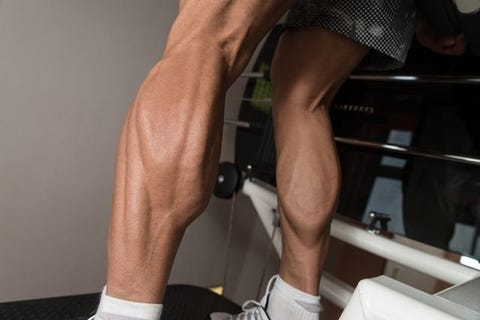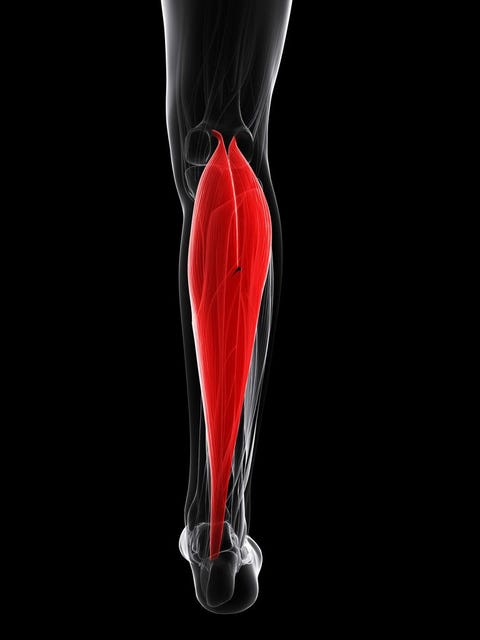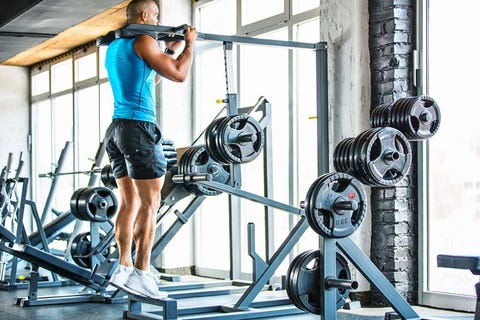The Ultimate Calf Training Guide

Your calves should be your lower-body biceps, the show-and-go muscles for your legs. But some people just develop a monster set of calves while some people can train their calves daily for their whole lives, chasing calf glory.
Either way, you want a big, muscular set of calves, because they’re the leg muscles that separate the smart lifters from everyone else. Don’t have calves? You may be the punchline of the next “skipped-leg-day” meme.
Get them by training smartly. Working your calves, just like your biceps, is a matter of understanding the anatomy that’s involved. Here’s what you need to know.
A Calf Muscle Anatomy Lesson

The calf muscle you see is actually two muscles: the gastrocnemius and the soleus. The soleus is the larger muscle, and it lies just beneath the gastrocnemius. The gastroc (you didn’t think we’d write the whole thing out for this entire story, did you?), however, is the muscle most people think of when you say “calf.” It’s the ball of muscle that contracts at the top of your lower leg, and it works to push the foot downward. It also assists in bending your knee.
Both muscles require different weight room approaches. To hit the soleus, you’ll want to do standing movements that attack your calves, because the soleus attaches below the knee. The gastroc, meanwhile, attaches above the knee. A bent-leg movement for the calves, such as a seated calf raise, will prioritize the soleus, because it will be at full tension while the gastroc will be lax.
Thing is, the soleus lies under the gastroc. If you want massive, shapely calves, you’ll need to train the gastroc. Ever see those people hammering away at seated calf raises and nothing else? That’s why they often don’t have jacked calves; they’re not hitting the gastroc.
Calves Take Time (and Time Under Tension)

Getty Imagesgilaxia
Your calves are composed primarily of slow-twitch muscle fibers, which are generally more fitting for long, endurance activity. The thrive in duration but fall short on power. That makes sense, especially since you walk and stand often throughout the day. You rely on your calves for support.
Too many people try to train calves by bouncing weight on top of their knees during seated calf raises. That won’t get results. Train calves with slower reps, more volume, and long duration. You can also train your calves frequently. Remember: You’re walking and standing every day.
Train calves with slower reps, more volume, and long duration.
All of this means you should approach calf training differently than you approach other bodyparts. You can train them with very high reps, because they essentially deal with high reps over the course of your day. You can also train them more frequently than, say, your chest. Your pecs may not be meant to shoulder a heavy weight every day, but your calves? They keep you standing up on more than Tuesdays and Fridays, so aim to train them at least three days a week.
Concentration with each rep is also key. Aim for a two-second pause on each rep to insure a quality contraction.
The Calf Attack Workout
Directions: Do this workout three times a week, focusing on form.
In-to-Out Standing Calf Raise
Pushing on different points on the balls of your feet (metatarsal) can have different emphasis on the calves. Pressure towards the inside of the foot adds more interior pressure on the calves while pressure towards the outside of the foot adds more exterior pressure. In-and-out calf raises insure you hit both portions of your calves equally.
To do them, stand with straight legs on a raised surface, so your heels are off the ground. Grip something in front of you for support. Sink your heels down until you feel a full stretch in the calves. Press the balls of your feet into the ground, elevating your heels as high off the ground as possible. Do 10 reps like this, making sure your toes face each other. Then do another 10 reps, focusing on keeping your feet fully straight, toes pointed in front of you. Finish with 10 more reps, this time with your heels pointing toward each other. Do 2 sets.
Cliffhanger Stairs

Getty Imagessantypan
Calf training doesn’t need to be all calf raises. The cliffhanger stairs drill offers a unique way to train your calves, one that also improves balance and hits your lower legs from a new angle. This drill trains your lower legs in a real-world way, too, teaching them to control your bodyweight.
To do these, find a staircase. Simply walk up the stairs, never letting your heels touch the ground. The balls of your feet should be the only parts of your body in contact with the ground. Use a railing for balance if needed, but don’t let your arms hold your weight. Walk up and down the stairs in this fashion for 60 seconds. Do 5 rounds like this, resting 30 seconds in between each.
Seated Calf Raise
Soleus development is important for big calves, and to do this, you’ll want to do the move you see most guys doing in the gym. No move isolates the soleus quite like the seated calf raise. To do one, hop into the seated calf raise machine at your gym. Sit into the machine, with the balls of your feet on the raised surface, and allow your heels to as far down as needed to feel a full stretch in the back of your lower leg.
With the weight resting on top of your knee, press into the ground until your heels are elevated as far as possible from the floor. Pause at the top for 1 second, then slowly return down to the starting position. Complete this for 4 sets of 20 reps.
Source: Read Full Article


